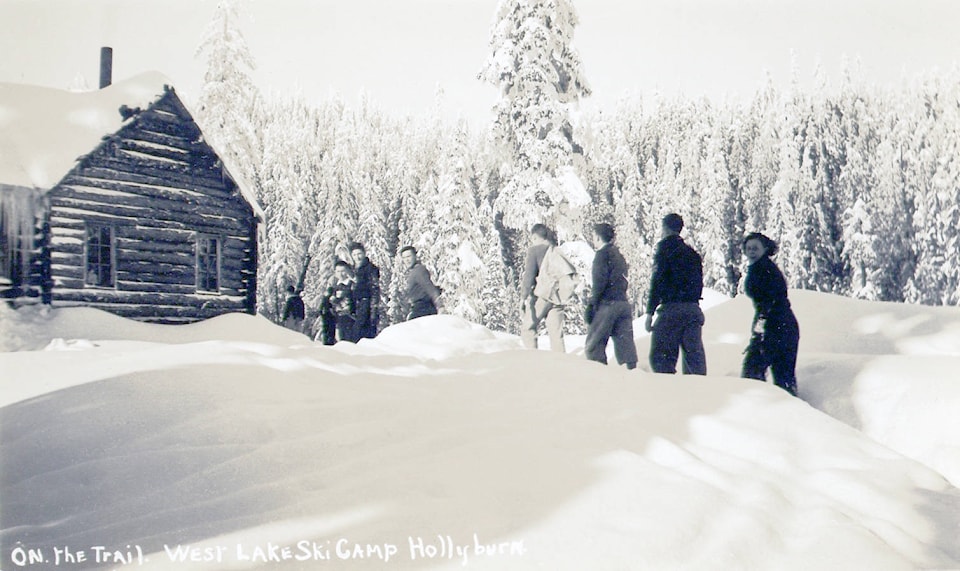As the Great Depression gnawed away at his financial resources, Edward Mahon sought out other ways to supplement his dwindling income. One of these was to develop a year-round recreation area on mountain property that he had been holding and paying taxes on since 1911.
Encapsulated within his 560 acres of forest was a small lake, located high above the Capilano Valley, where Edward’s suspension bridge was located. Originally accessed by a steep trail from the valley, the cluster of small lakes on Hollyburn Ridge was now being developed for winter recreation. Edward decided to enter the competition and develop his West Lake property as a prime ski resort.
What propelled him in this direction was the discovery that British Pacific Properties Ltd., backed by Guinness money, was planning a major high-class subdivision for the southern flank of Hollyburn Ridge. To make it viable as a residential community, a bridge at First Narrows was in the offing as well. Edward commenced negotiations with A.J.T. Taylor, in the hope that the syndicate would purchase his holdings and develop an all-year recreation resort on the site. When the syndicate backed away from a deal, Edward decided to go it alone.
He hired R.D. Brewis to build a mountain hotel on the shores of the lake. Work commenced in the summer of 1932, with the construction of a new trail from West Vancouver. Building the chalet was next. It was a daunting undertaking, as the structure was built entirely of logs obtained on the property, and its construction was a race against snow, which threatened to bury it before the roof could be installed. Perseverance, however, paid off, and on March 18, 1933, the impressive structure was ready to host the first guests.
The building consisted of a large central lobby equipped with a metal fireplace; rental skis were stacked against the log walls. A Dutch door opened into the kitchen that served refreshments to the guests. Florence Barr was hired as a cook and onsite manager of the operation. Small rooms in the outlying wings provided bunk beds with comfortable mattresses. Later, a telephone line was installed to make communication with the outside world easier.
And that world was quite a distance away. A team of young packers was kept busy backpacking all the necessities to the remote location. These included stoves, bed frames, mattresses, other furniture, rental skis and all the groceries. The guests had to be hardy too, as it was a hike of several hours to make it to the lodge, which at times was totally buried by the snow.
Part of the small lake was cleared of snow so guests could either skate or ski on its surface, and on occasion, they were serenaded by a resident orchestra. The more daring skiers ventured up the slopes for the thrilling run down onto the lake surface. Some pursued loftier destinations, like the top of Hollyburn Mountain itself. Edward’s resort had to compete with Hollyburn Lodge, which had been built further to the west on First Lake, a small reservoir.
Here a modest ski jump had been erected. Not to be outdone, the West Lake resort constructed its own ski jump, whose natural hill was given additional altitude by a wooden accelerating platform at the top. Edward started hosting ski jumping competitions, for which he provided the trophies. It soon attracted serious competitors, who declared the jump second only to the one at Revelstoke. Edward also encouraged summertime utilization by offering a sound pair of boots to the most avid hiker.
In 1936 new negotiations with Taylor were commenced, this time for the sale of a fully developed facility. They collapsed later that year, most likely as the developer realized what was in the offing.
Unfortunately, the operation was doomed. Brothers Creek drainage, of which it was part, was adopted by West Vancouver for its new water supply, and Edward had to divest himself of lands that were part of that watershed. He previously had to give up Hollyburn lands that formed part of the Capilano watershed, adopted by Vancouver for its water supply.
The operation closed in 1937, after Edward’s death in June. Jones brothers, to whom Brewis had sold a block of land across the watershed divide, dismantled the lodge. They skidded the components onto their property, where it took on a new form as the Westlake Lodge. The ski jump was dismantled in May 1938, and the area was closed to the public. Lions Gate Bridge opened for service on Nov. 14 of that year.
